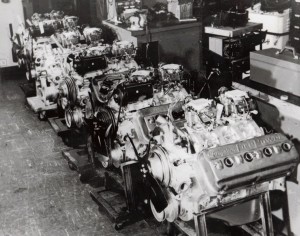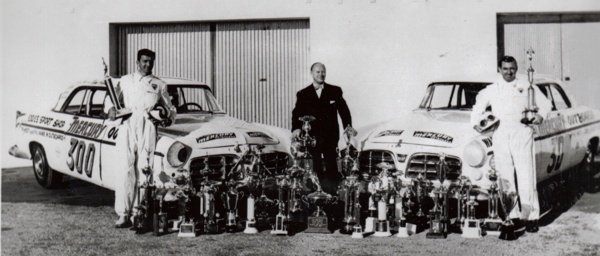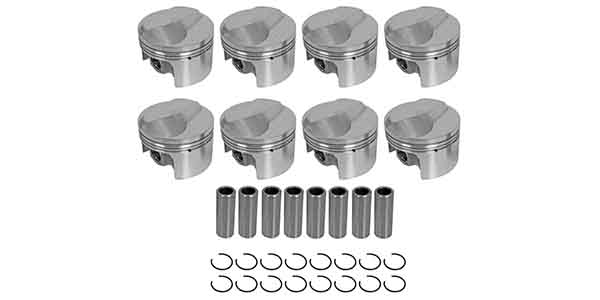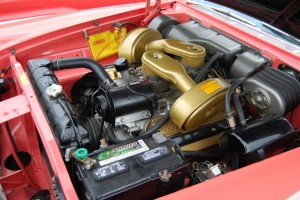
If you pick up a copy of Bill Weertman’s 2007 book Chrysler Engines 1922-1998 and turn to page 345, you’ll find mention of an SAE paper that Neil Newman authored in 1964 on converting the Mopar Slant Six from passenger car to pleasure boat use.
At the time, Weertman, was head of the Chrysler Corp. Engine Development Lab when Newman worked there. What his book doesn’t mention is that Newman — before his tenure with Chrysler Marine Division — had also gone to school at the Chrysler Engineering Institute (CEI) with many members of the original legendary “Ramchargers” drag racing team.
The High & The Mighty
According to Petersen’s History of Drag Racing (published in 1981), “The original Ramchargers Car Club standard-bearer was Herman Mozer’s awkward, awfully quick ’49 Plymouth C/Altered.” This box-on-box Plymouth featured the first ‘high ram’ intake system (later copied by the big commercial manifold manufacturers). Herman Mozer was officially in charge of coordination for the Ramchargers team and his “High & Mighty” Plymouth became so famous that a replica of the aptly-named coupe now resides in the Walter P. Chrysler Museum in Auburn Hills, MI.
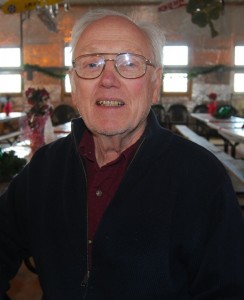
Neil Newman wasn’t a member of the Ramchargers, but he was an engineering student at the Chrysler school when the racing team members were enrolled there. “Many of the older drag racers have heard of the Ramchargers,” said former Ramcharger member Billy Shope in his Motorsports Village (www.motorsportsvillage.com) article entitled “The Ramchargers, How it all Began . . . “
According to Shope, “Without the Institute, there is little likelihood that the Ramchargers ever would have come into existence.”
CEI: A Focus on Engineering & Education
CEI was an educational facility that Chrysler Corporation financed and ran for many years. From the start of the company in 1924, Chrysler Engineering flourished because Walter P. Chrysler — himself an engineer — supported it with buildings, equipment, staff and funds.
The completion of the Engineering Building, at the former Maxwell plant in Highland Park, in 1928, symbolized his commitment. The four-story building cost $1 million at that time and provided 960,000 sq. ft. of space for labs, drafting, testing, showrooms and offices. Chrysler Corp. then established its own “college of engineering” in 1931, when it launched CEI.
The corporation employed hundreds of engineers and felt that it needed to train both college grads and those with prior work experience in the “Chrysler way.”
During its first 10 years, the Institute held classes all over the Chrysler home plant in Highland Park, MI, and at Highland Park High School. A new Chrysler Institute Building opened on Oct. 1, 1942. It featured 20 classrooms, six drafting rooms, six engineering laboratories and an auditorium.
CEI started as a graduate program that admitted students with a recent college degree in hand for a two-year postgraduate education with “hands-on” practical experience.
Chrysler paid them a starting engineer’s salary while they attended classes and completed different assignments in various departments within the corporation. They earned a Master of Automotive Engineering degree. Later, a night-school program was added as well.
Each CEI graduate student was also a full-time Chrysler employee. They spent two hours of each day in the classroom and six hours on a student assignment. The student assignments were rotated between different departments. After a student earned his degree, he would be placed in a permanent assignment.
“I went to school for two hours a day and worked in the engineering laboratory for six hours,” Newman recalled in an interview with Engine Builder. “I got to try six different assignments as I went through school and I liked designing engines the best.”
According to Newman, “The Engine Design Group made the engine, the Engine Development Lab made it work and the design group got it back to figure out how to manufacture it. I wanted to work in the Engine Design Group, but because of office politics between the groups, I could not transfer into the Engine Design Group and I stayed in the Engine Development Lab.”
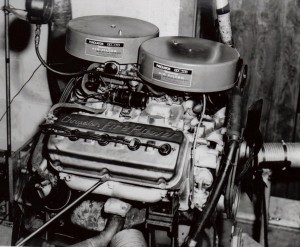
The “Leaning Tower of Power”
Newman, now a resident of the village of Omro, WI., attended CEI from 1957-1959 as a student in the two-year graduate program and started work in the Chrysler Engine Development Laboratory in 1960. “I did mostly Slant Six stuff,” says Neil. “But I played with Hemis, too. They were still using first-generation Hemis from the mid 1950s in the lab and the test car we had was a Hemi-powered De Soto that we used for developing camshafts.”
As part of his student assignment, in the early 1960s, Newman helped develop a ram manifold for the “Leaning Tower of Power” — the Slant Six. Newman remembers, “I worked on the performance development aspects of the Slant Six like intakes, camshafts and exhaust systems.”
Newman swears that there was a Slant Six in the Engine Development Lab with a special intake carrying dual four-barrel carburetors.
Engine Builder asked if he might be thinking about the Hyper Pak — a kit of 14 dealer-installed high-performance parts that Chrysler created to use on Valiants that ran in the compact car races at Daytona in 1960. “No, it was a dual quad setup,” he insisted with a smile on his face. “And we got a tremendous amount of horsepower with it, but it didn’t idle well.”
Hemi Highlights
During his time in the Engine Development Lab, Newman has recollection of Goodyear or Firestone using a Chrysler-engined racing car that ran on “alky” (alcohol fuel) to test tires. “Firestone was also building an Indy car with some form of Hemi engine,” Newman told us. “An Offy engine would only last 500 miles before it needed to be rebuilt, but the Hemi would last for many more test cycles.”
Newman also worked on an exhaust system for the 1957 Chrysler 300 Letter car with the short-lived Bendix electronic fuel-injection system.
“We would chase all over for a one-half percent gain in performance back then and that much was considered a big improvement,” he explained. “One year, we managed to up the horsepower of the C300 by a small percentage, but customers complained that the engine didn’t perform as well. We discovered that with the exhaust, people had redone the mufflers and taken a baffle out, and the complaints we were hearing were actually a reaction to the louder noise, rather than the car’s true performance, which was good.”
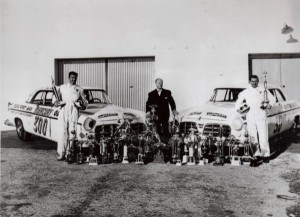
Fast Times at “Ramcharge High”
According to Billy Shope, the Ramchargers racing team grew out of a lunchtime conversation that took place between classes at CEI. Enthusiasts like Wayne Erickson (a good friend of Neil Newman), Trant Jarman, Scott Harvey, Herman Mozer, Barnes Daniels and Shope would inevitably turn to racing when they began talking over their break. It was discovered then that each of them wanted to go drag racing, but didn’t have the money to do so. Then, someone suggested pooling their finances to buy and build a racing car. As might be expected from well-trained Chrysler engineering students, they formed committees to help get the job done.
For example, Dick Burke and Dick Maxwell were appointed co-chairmen of suspension, traction and steering, while Skip McCully and Maurie Leising were co-chairman of the engine. The goal was to build a Mopar that could outrun the big-block Chevrolets that were winning races at that time.
The group had hoped to start with a 1930s Chrysler model, but such cars proved to exceed the amount they had to spend on such foolishness. Then, they came across a little 1949 Plymouth business coupe and purchased it. There were about 25 members of the Ramchargers originally and each of them kicked in a little over $30.
They worked off the cost of the car’s 354-cid Hemi engine by doing a set number of warranty engine teardowns over at Dodge Truck Division.
“While I wasn’t in the club, we all knew about it and it was an exciting time for everyone taking courses at CEI,” Neil Newman recalls. “Here I was, a young guy interested in engines and all of my classmates were part of the Ramchargers. I was designing exhaust manifolds at the time and my best friend Wayne Erickson was in the Ramchargers and had a drag car.
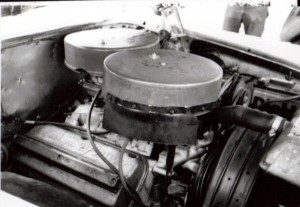
Erickson (who was killed in a drag racing accident weeks later) needed a camshaft for his car. “All Wayne wanted to do was run as fast as possible in the Nationals,” explained Newman. “He wasn’t at all interested in how the car would perform on the street — he wanted a cam designed only to go really fast. We worked with outside suppliers to custom make cams for lab testing, so I designed a wild cam for Wayne and had our cam company make it for the lab.”
With this special cam, Erickson’s Dodge dragster went like a rocket. “The Isky people came to him, asked him who did his cam and said they could make him up an even hotter one because they had a dyno and all kinds of equipment,” Newman remembers. “Wayne looked at them and said, ‘My cam designer has 34 dynos!’ and we really did have that many in the lab.” (Chrysler Engineering actually had a complete Dynamometer Building constructed in 1939!)
The thing the Ramchargers were most famous for was an unusual-looking intake manifold they built for The High & Mighty Plymouth. Chrysler Engineering was doing a lot of experimental work with ram tuning technology at the time, so the boys placed a plenum above the car’s engine and supported it with steel angle and somehow it worked.
Their low-buck bomb set the best class speed record on its first outing at the National Hot Rod Association Nationals in 1959.
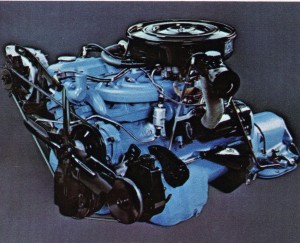
The Goldenrod
Another person that Neil Newman was friendly with was Pete Dawson, who worked on the Summers Brothers’ “Goldenrod” World Land Speed Record car.
Sponsored by Firestone and built by Bill and Bob Summers, of Ontario, CA., the torpedo-shaped streamliner set four fuel-injected Chrysler Hemis in a row to achieve a total of 2,400 hp. It is a beautiful machine, which the author saw close-up when he traveled to a German auto show in the 1980s and spent time with Bill and Bob Summers. Lord Montagu, a British collector of WLSR cars, wanted to buy the Goldenrod then, but it now resides in the Henry Ford Museum.
At Utah’s Bonneville Salt Flats, in the fall of 1965, Bob Summers piloted the Goldenrod to 409.695 mph, which to this day is the land speed record for un-blown cars.
Dawson was later contacted to help restore the car before it went on display in Dearborn.
“Floating Power”
“Floating Power” was a term that Chrysler had used to describe an improved engine-mounting system for its 1931 Plymouth PA model. The term also describes Neil Newman’s career in the ‘60s.
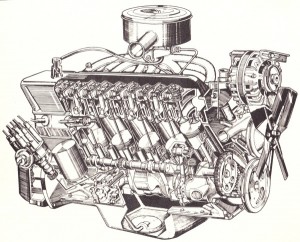
Unhappy with some of the inter-departmental politics at Chrysler, Neil went to work for McCulloch, which had purchased the Scott-Atwater Outboard Boat Motor Co. in 1956. Newman worked at a Minnesota facility and helped develop a three-cylinder aluminum 60-hp outboard that was sold under Scott, Scott-McCulloch and McCulloch branding.
When McCulloch moved his department from Minneapolis to Los Angeles, Neil left to go back to Chrysler Marine in the ‘60s, when he wrote the SAE Paper cited in Bill Weertman’s book.
Ironically, he then went to work for Carl Kiekhaefer’s outboard marine corporation Kiekhaefer Marine, in Fond du Lac, WI, (later to be named Mercury Marine).
Kiekhaefer, ironically, had used NASCAR auto racing with 1955 and 1956 Chrysler 300 stock cars to promote his outboard motor business almost a decade earlier.
Later, Newman moved to Mansfield, OH to work for Gorman-Rupp. Newman says that he worked “about three years” in each of these jobs and after he left Rupp, he moved back to Wisconsin to work for Kiekhaefer again.
In all of these jobs, Neil Newman focused on boat engines, including a Low-Silhouette Space Saver 225-cid RG Slant Six marine engine that he played a major role in designing and developing. This engine featured a unique box-like casting that formed its oil sump. While at McCulloch, he won an award for industrial design work on a speedboat that competed against the Anheuser-Busch racing boat.
